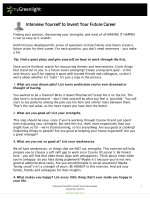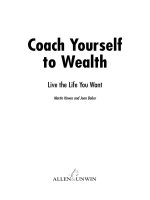Managing Yourself: Coach Yourself To Optimum Emotional Intelligence pot
Bạn đang xem bản rút gọn của tài liệu. Xem và tải ngay bản đầy đủ của tài liệu tại đây (879.51 KB, 185 trang )
managing yourself
DO THIS –
LIFE GETS
AND YOUR
BETTER
managing yourself
coach yourself to optimum emotional intelligence
Paul Morgan
www.yourmomentum.com
the stuff that drives you
PEARSON EDUCATION LIMITED
Head Office:
Edinburgh Gate
Harlow CM20 2JE
Tel: +44 (0)1279 623623
Fax: +44 (0)1279 431059
London Office:
128 Long Acre, London WC2E 9AN
Tel: +44 (0)20 7447 2000
Fax: +44 (0)20 7447 2170
Website: www.yourmomentum.com
Website: www.business-minds.com
First published in Great Britain in 2003
© Pearson Education Limited 2003
The right of Paul Morgan to be identified as
Author of this Work has been asserted by him
in accordance with the Copyright, Designs and
Patents Act 1988.
ISBN 1843 04023 9
British Library Cataloguing in Publication Data
A CIP catalogue record for this book can be
obtained from the British Library.
All rights reserved; no part of this publication
may be reproduced, stored in a retrieval
system, or transmitted in any form or by any
means, electronic, mechanical, photocopying,
recording, or otherwise without either the prior
written permission of the publishers or a
licence permitting restricted copying in the
United Kingdom issued by the Copyright
Licensing Agency Ltd, 90 Tottenham Court
Road, London W1T 4LP.
This book may not be lent, resold, hired out or
otherwise disposed of by way of trade in any
form of binding or cover other than that in
which it is published, without the prior consent
of the Publishers.
10 9 8 7 6 5 4 3 2 1
Typeset by Northern Phototypesetting Co. Ltd,
Bolton
Printed and bound in Great Britain by
Henry Ling Ltd, Dorchester
Cover design by Heat
Text design by Claire Brodmann Book Designs,
Lichfield, Staffs
The Publishers’ policy is to use paper
manufactured from sustainable forests
.
momentum managing yourself opening
vii
pages vi /
thank you…
Thanks to Neil Moult at Vision2learn.com and Rachael Stock at momentum for
having faith in my Emotional Intelligence expertise.
I would like to dedicate this book to Marie and Natasha.
are you the sort of person who should read
this book?
/ 2
how this book differs from traditional self-help books / 3
rags to riches / 4
hugging trees / 4
perfect methods / 5
what is emotional intelligence? / 7
about the book / 11
chapter one
my promise to you
momentum managing yourself contents
ix
pages viii /
old maps / 14
a room without chairs / 15
when I click my fingers you’ll think you
are Elvis
/ 16
how the model works / 21
quadrant II / 22
control central / 28
chapter two
old maps and empty rooms
it’s a wonderful life / 34
blind spots and Johari windows/ 35
levels of emotional awareness / 37
how do you feel? / 40
as time goes by / 40
the DREC curve / 41
DREC and QII / 43
activities / 44
chapter three
self-awareness – it’s a wonderful life
momentum managing yourself contents
xi
pages x /
the Yale experience / 56
goals and RAS / 59
ethics and goals / 60
the power of purpose / 61
Julie Andrews v. Doris Day / 63
activities / 64
chapter four
goal setting – step forward
Julie Andrews
Data and Counsellor Troi / 74
empathy / 74
getting to know you / 76
the seven per cent solution / 78
knowing me, knowing you / 79
the dark side of empathy / 80
activities / 80
chapter five
empathy – knowing you
momentum managing yourself contents
xiii
pages xii /
Spock v. Kirk / 90
Einstein’s insight / 90
what CEOs really feel / 92
the uses of intuition / 93
you and your intuition/ 94
trusting your hunches / 96
activities / 98
chapter six
intuition – magical feelings
developing trust and integrity / 106
rapport and traditional approaches / 108
three levels of communication and social skills / 110
the heart of social skills: integrity / 112
integrity in others / 114
fairness and trust/ 114
deeper listening/ 116
heartmapping/ 117
activities/ 119
chapter seven
integrity: you can’t fake it
momentum managing yourself contents
xv
pages xiv /
ever-changing world / 126
waves of change / 126
what is creativity? / 128
catching monkeys/ 131
empty car parks/ 132
two models of creativity/ 132
killing creativity/ 137
activities/ 139
chapter eight
creativity – catching monkeys and
empty car parks
Holyfield’s ear / 152
why two marshmallows are good for you / 154
getting mentally tough / 155
please release me/ 159
activities/ 162
chapter nine
emotional management –
marshmallows and mental toughness
momentum managing yourself contents
xvii
pages xvi /
chapter ten
just do it!
chapter one
my promise to you
momentum managing yourself chapter one
1
pages xviii /
Are you the sort of person who should read this
book?
I was tempted to omit this section. Or hide it away in the text. Surely
it would be better to have you buy the book and then work out
whether it is of any use to you. That way I get my royalties whatever
the result! However, on reflection, I would be happier for the casual
browser to look through this section and then make their buy/don’t
buy decision. I would like those people who read through the
checklist and decide they don’t need the book to get in touch with
me – if you are one of these you are a very rare species. Take a look at
the checklist below now.
Checklist
Read through the questions below. If you answer no to any of the
questions then the techniques in this book can help you.
◆ Do you have a detailed knowledge of how your beliefs, thoughts
and feelings influence the results you get in life?
◆ Do you have a high level of self-awareness of how you think and
feel and how life events influence your thoughts and feelings?
◆ Do you have a clearly defined personal vocation?
◆ Do you know how to set goals in ways that maximize your results?
◆ Are you adept at reading the emotional responses of other
people?
◆ Do you know how to access and use your intuitions?
◆ Are you able to build trusting relationships?
◆ Are you readily able to come up with creative ideas that work?
◆ Are you able to easily tap into the emotional response that
maximizes your results?
◆ Are you mentally resilient when put under pressure?
If you have answered no at any time then this book is for you. It is
packed full of techniques that will show you a lot about yourself that
you probably didn’t know and that will help you to develop a whole
range of skills and attributes that could really change your life. You’ll
develop self-awareness and uncover how much you are doing ‘on
automatic’ without knowing you do it. You’ll be helped to find your
true vocation in life. You will also learn how to tap into your natural
intuitions and creativity. You’ll learn how to ‘read’ other people and
how to build high-quality, trusting relationships. You will learn how to
manage your emotions so that you are happier and more successful.
This book will also give you the tools and techniques to make
changes if you want to do so. It may sound, to you, like just another
self-help book. So, what’s the difference between this book and
others you may have read?
How this book differs from traditional self-help
books
This book is about managing your most vital asset: you. It will focus
upon helping you to improve the quality of your life. The smart
reader will already have, rightly, concluded that this is a personal
development book. I want it to be different from the traditional self-
help books, so here I am making three promises to you, the reader:
1 You will not be subjected to my autobiographical rags to riches
story.
2 You will not be asked to hug trees or speak to your guardian angel.
3 You will not be promised that each technique in this book works
perfectly every time.
momentum managing yourself chapter one
3
pages 2 /
Rags to riches
‘I once was lost and now am found.’
Lyric from ‘Amazing Grace’
I have read a few personal development books in my time. Often a
large portion of the book is dedicated to the author’s life story.
Invariably, they start out as a ‘loser’. They were bankrupt, addicted
to something or in broken relationships – or often all three. They
were at rock bottom. Then they learned about the ‘method’. This is
some approach or technique that completely turned their life around.
Now the personal development guru is living a wonderful life.
Everything in the garden is rosy. And it is all due to the ‘method’ that
you can now buy in seminar, audio, video or book format.
The guru has gone from zero to hero. They have become rich by
telling others how they became rich. By doing this, they have painted
themselves into a corner. If they admit to any difficulties in their life
then their method and their business and their whole livelihood is
threatened. Fortunately, they all appear to have perfect lives!
Sadly, for the purposes of this book, I do not have a heart wrenching
story. I have never been in rags. A few problems here and there but
rags, no. Nor have I become a mega-millionaire by selling a few easy-
to-use techniques. However, I know that my experience and the
experiences of hundreds of thousands of other people show that it is
possible to make quick, permanent and positive changes in your life.
Hugging trees
One of the most popular approaches to personal development arises
from the study of ancient cultures and religions. Or from the
religious experience of a charismatic leader. There are thousands of
these to be found in book or seminar form. You may end up hugging
a tree. You may get in touch with your inner child or your guardian
angel (possibly both). Elsewhere, you may get the chance to relive
your birth. All these methods and more may be enjoyable. They may
work but they will not be addressed in this book.
The bulk of the approaches described above have not been tested
rigorously. Nor proven scientifically. There has not been a systematic
review of the claims being made for these approaches. In contrast,
the outstanding research that underpins what is found in this book
has been done in real-life contexts. It has measurably improved the
lives of tens of thousands of people. When ‘alternative’ approaches
prove themselves in a similar way, their ideas will be found in this
book.
During the previous 10 years, this detailed research has been brought
together under the heading of ‘Emotional Intelligence’. This term
will be explained further later in this chapter. What is abundantly
clear is that there are behaviours, competencies, and skills that can be
called emotional intelligence (EI). It has been scientifically proven
that a higher EI is linked to a better quality of life. Most important, it
is abundantly clear that EI is not fixed. You can increase it and reap
the benefits. This is not an act of faith – like alternative methods are.
It is an act of fact.
Perfect methods
‘I am not perfect but parts of me are excellent.’
Ashleigh Brilliant
Let me be absolutely unequivocal about one thing: The techniques in
this book work perfectly – except when they do not. I won’t sit on the
fence on this issue.
The notion that the formulaic use of half a dozen techniques will
always transform your life is nonsense. It is a dangerous nonsense.
Every person is unique. They have a unique genetic structure
(identical twins excluded), unique environments and have a variety
of situations in which they live. To suggest that a one-size-fits-all
method is a cure all is a little . . . iffy.
momentum managing yourself chapter one
5
pages 4 /
The notion that the formulaic use of half a dozen
techniques will always transform your life is
nonsense.
One of the less attractive outcomes of this perfect approach is the
way its users may be treated if positive results are not forthcoming.
One common response is to blame the user – they obviously did not
apply the techniques correctly. When this happens the user has failed
to understand something. Few personal development gurus will
question their own powers of explanation! Alternatively, the user is
said to have been undisciplined in their use of the technique. The
implication is always clear; the master used it diligently and
succeeded, which means you can too. If the expert can go from rags
to riches then so can you. For the gurus a poor result by a user means
they must either question their techniques or the user. No contest!
In this book you will be given dozens of proven techniques for
improving your life. The challenge for you is to try them out and
find what works. Yes, you will have to be thorough and disciplined.
In all likelihood the exercises and techniques will help you to
improve your life. Some will work very quickly. However, should
you find that some techniques do not work for you, do not worry. If
you have really tried something out there is probably a very good
reason for your lack of progress: the technique is not for you. There
does not need to be blame or guilt or any sense of failure. Simply
conclude that, at this point in time, the technique was not for you.
Then move on and use something else. Take a look at other
techniques in this book, look elsewhere and speak to other interested
people. Do so until you find something that works for you. There is a
simple four step process for using any life-improvement techniques:
1 Ensure you are using the technique as prescribed.
2 Be willing to experiment with your improvised variations if step 1
does not work.
3 Be confident that you ‘gave it a go’.
4 If steps 1–3 still do not bring the desired results, you should
conclude that the technique is not for you. Find something else
that will work.
When an approach to personal development relies on a few
techniques then it can ill afford to disregard them. There will be
many techniques provided in later chapters. Your mission – if you
choose to take it – is to apply the techniques and find out which ones
work for you.
A lot is known about the personal qualities that cause a person to
have a better quality of life. They are covered in the introductory
checklist (see page 2). These qualities can be managed by you. Once
you spot any personal weaknesses you can take action and make
positive changes. All these qualities – such as goal setting, intuition,
creativity and resilience – have been studied for decades by
psychologists. In recent years the many strands of diverse research
have been drawn together and it is collectively referred to as
Emotional Intelligence. So let’s take a closer look at this concept.
What is emotional intelligence?
If you are going to manage yourself successfully then you need to
understand the psychological ideas that underpin Emotional
Intelligence (EI). These ideas offer all of us the opportunity to take
control of our lives and significantly improve their quality.
IQ and other models
For over a hundred years psychologists have defined, measured
and used the concept of the Intelligence Quotient (IQ). Such was
their success that IQ became the one and only way to define what
makes a person intelligent. The key intellectual elements of IQ
were:
◆ linguistic skills
◆ analytical skills
◆ spatial orientation
◆ logical reasoning.
While this approach continued to be influential, it was challenged. It
was obvious that many gifted and talented people did not necessarily
score well in IQ tests. This did not seem to make sense. From the
1970s onwards, new approaches emerged. A highly influential model
momentum managing yourself chapter one
7
pages 6 /
came from the research of Howard Gardener, a professor of
psychology at Harvard. He developed the idea of multiple
intelligences (MI). In his definitions there were seven categories:
1 Linguistic – talent with language
2 Mathematical/Logical – talent with maths/logic/systems
3 Visual/Spatial – visual talent
4 Musical – talent with music
5 Bodily/Physical – talent with movement and co-ordination
6 Interpersonal – social talent
7 Intrapersonal – talent for inner control and understanding.
The multiple intelligence approach makes a lot more sense to the
layperson. There are athletes and dancers with phenomenal physical
intelligence who may not be good at mathematical reasoning.
Likewise, there are gifted musicians or those people who have great
interpersonal skills who may not score well on a traditional IQ test.
When you take a look around at many of life’s achievers, they may
not have the highest IQ. However, they are very likely to score
highly in one or more of the multiple intelligences.
In 1990, Dr Peter Salovey and Dr John Mayer published two articles
on the subject of emotional qualities and capabilities. They provided
the first formal definition of emotional intelligence and provide the
first demonstration that certain ability tasks could be used to
measure this concept.
‘Emotional Intelligence involves: the ability to perceive
accurately, appraise and express emotions; the ability to access
and/or generate feeling when they facilitate thought; the ability
to understand emotion and emotional knowledge; and the
ability to regulate emotions to promote emotional and
intellectual growth.’
Mayer & Salovey (1997)
It was in 1995 that most people became aware of EI. This was due to
the best-selling book by Dr Daniel Goleman, Emotional Intelligence:
Why it can matter more than IQ. In this book, Goleman presented a
detailed account of cutting edge research, some of it based on studies
that had run for decades. It showed that people with higher
emotional intelligence were healthier and happier.
Reuven Bar-On is the Funding Director of the Institute of Applied
Intelligence. He has been a central figure in the defining, measuring
and applying of EI since 1980. He coined the term ‘EQ’ and created
the first test of emotional intelligence.
Approaches to clustering emotional intelligences
There are many active researchers and writers on this subject. They
cluster EI abilities in a number of ways (see below).
Salovey and Mayer
◆ identifying emotions
◆ using emotions
◆ understanding emotions
◆ managing emotions
Goleman
◆ self-awareness
◆ self-management
◆ social awareness
◆ social skills
Bar-On
◆ intrapersonal skills
◆ interpersonal skills
◆ adaptability
◆ stress management
◆ general mood
We do not need to concern ourselves with the schisms and conflicts
in the world of EI. What is evident from all the research, however, is
that a higher EI is strongly correlated with a higher quality of life,
momentum managing yourself chapter one
9
pages 8 /
and that it is possible to raise EI levels through training. This final
point is crucially important. We can improve our emotional
intelligence and improve our lives.
The research shows that EI competencies and skills make a difference
in business performance. David McClelland (1998) reviewed 30
companies and found that higher EI scores differentiated the top
performers from average ones. Likewise, Boyatzis (1999) showed that
distinguishing factors among high-level leaders were EI competencies.
He found that these competencies raised incremental profits in the
financial services sector by 78 per cent up to a staggering 390 per cent.
A piece of research by Spencer and Spencer (1993) looked at high-
performing individuals in health and social services, technical, sales,
customer management, leadership and executive roles. Once again, EI
proved to be a key factor. Here are some of their findings.
◆ Centre for Creative Leadership identified that low EI was most
likely to cause career problems for senior executives.
◆ USA National Insurance company found that high EI staff
outperformed low EI staff by over 100 per cent.
◆ University of Manchester Institute of Science and Technology
found that high EI managers were healthier, happier and
performed better than others. They also reported that managers
can be taught to increase their EI.
◆ A study of 500 organizations indicated that those high on EI rise
to the top.
◆ Qualities such as emotional self-awareness, empathy and
problem solving are better predictors of sales success background
or sales techniques.
◆ Physicians in the USA who were low on empathy were more
likely to be sued.
One psychologist who has had a significant influence on emotional
intelligence research is Professor Martin Seligman. He has done
We can improve our emotional intelligence and improve
our lives.









